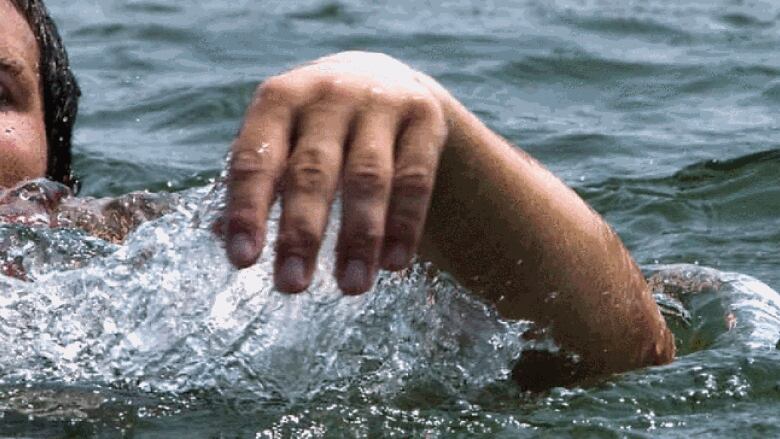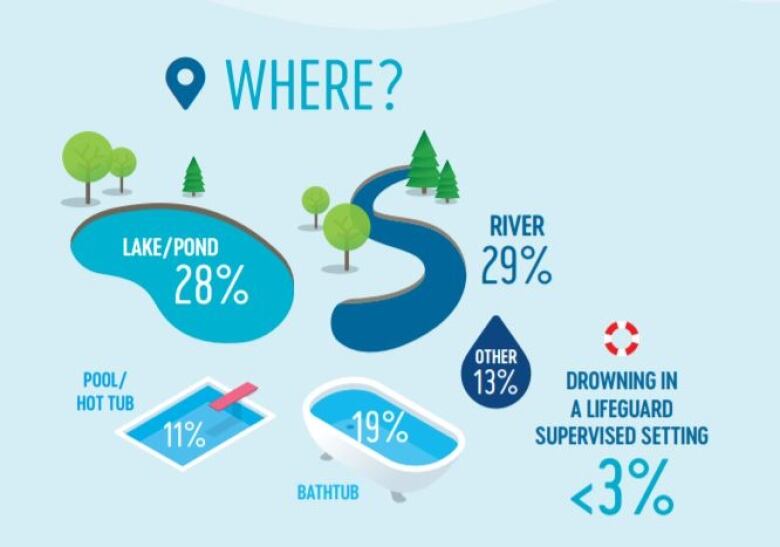72% of Alberta drowning victims are male, and they're often intoxicated: report
Officials stress importance of supervising children, wearing life-jackets

The rivers and lakes around southern Alberta are sure to be full of people cooling off this weekendas temperatures soar to the high 20s,and officials want them to enjoy their water activities safely.
Evidence suggests it's men specifically younger men who really need to get the safety message.
The latest data on drowning deaths in Alberta show that the vast majority of victims were male and that alcohol was a factor in more than half the cases where the victim was a young adult.
According to the 2018 edition of the Alberta Drowning Report, 72 per cent of people who drowned in the province from 2011 to 2015 were male.
Over that five-year period, 29 per cent of drowning victims were aged 20 to 34. Victims over the age of 65 accounted for 17 per cent of the deaths, and seven per cent were children aged four years or under.
42 drowningsin Alberta in 2015
In 2015, there were 42 water-related deaths in Alberta, down from 49 in 2014 and 56 in 2013. In 2011, there were 31 deaths, and 38 in 2012.
The report was compiled by the Drowning Prevention Research Centre Canada in collaboration with the Lifesaving Society Alberta and Northwest Territories using information from the Office of the Chief Medical Examiner of Alberta.
The report says 53 per cent of the young adults who drowned between 2011 and 2015 had consumed alcohol, while 41 per cent of the older adult victims had.
"There is usually some level of intoxication," said Kelly Carter, executive director of the regional lifesaving society, which teamed up with the national organizationto produce the report.
He added that intoxicants other than alcohol are just as dangerous around water.
Where drownings in Alberta occurred:

Carter says drowning usually happens silently and fast within 20 seconds.
His No. 1 message for parents is to be vigilant.
"Watch your children around water," he said.
"Supervision means paying attention," he said, noting that even walking away from a child in the water for a few moments can have tragic consequences.
The report found that in every case where a child drowned, adult supervision was either absent or distracted.
In theLethbridge area this week,the search continuedfor a 14-year-old boy who is believed to have drowned in theOldmanRiver.
The boy was swept away last Friday as he tried to walk across the river with a friend and the friend's grandmother. Searchers are now looking along the banks of the river after divers were unable to find the boy's body.
86% of young adultvictims not wearing PFD
According to the report, young adult drowning victims were not wearing a personal floatation device (PFD), such as a life-jacket, in 86 per cent of thosedrownings.
Among older adults, that figure dropped to 57 per cent.
Looking at all cases where the victim was boating, the report found that 74 per cent of the victims were not wearingPFDs, and 27 per cent had consumed alcohol.
In cases where a drowning victim was swimming, the report found that 40 per cent had been drinking and that32 per cent were weak swimmers or non-swimmers.
Calgary Fire Department spokesperson Carol Henke says learning to swim is vital, especially for newcomers to Canada from cultures where swimming is less common.
"I would strongly encourage people to make swimming one of those non-negotiable life skills that you can carry through your entire life," she said.
Older adult drowning victims were alone at the time in 64 per cent of incidents, compared with 39 per cent of the time for young adults.
The report also looked at the type of activity the victim was doing:
- 32 per cent were swimming.
- 17 per cent were walking,running or playing near water.
- 14 per cent were in non-powered boats.
- 13 per cent were diving.
- 9 per cent were in hot tubs.
Sixty one per cent of alldrowningsin Alberta from 2011 to 2015 happened during the warmer months, May to September.
The major risk factors:

- MORE CALGARY NEWS |Stampede's Indian Village to undergo name change in 2019
- MORE CALGARY NEWS |City launches 3 projects to spruce up Downtown West section of Calgary's core
- Read more articles byCBC Calgary, like us onFacebookfor updates and subscribe to ourCBC Calgary newsletterfor the day's news at a glance.












_(720p).jpg)


 OFFICIAL HD MUSIC VIDEO.jpg)
.jpg)



























































































